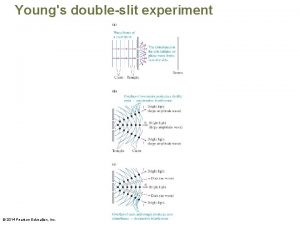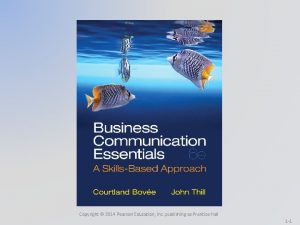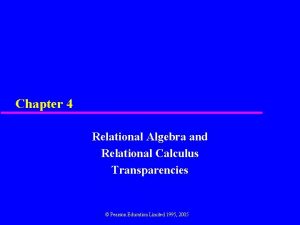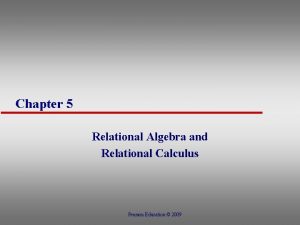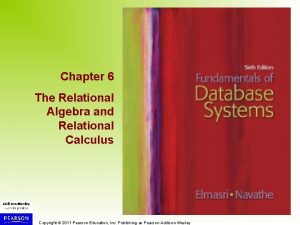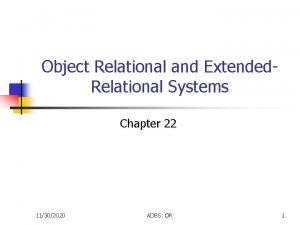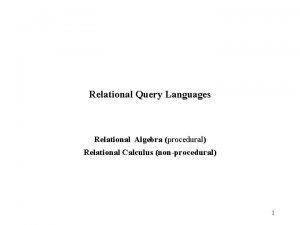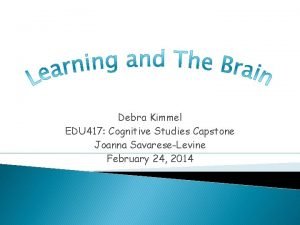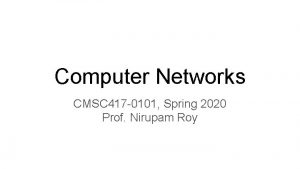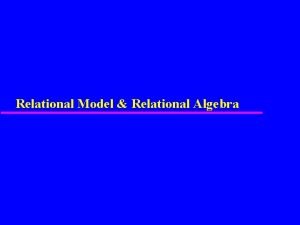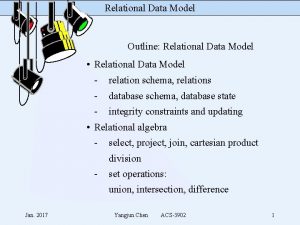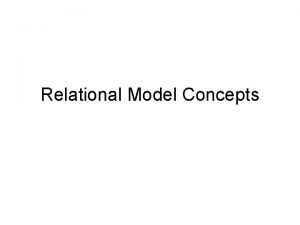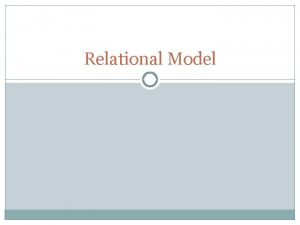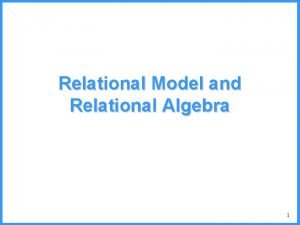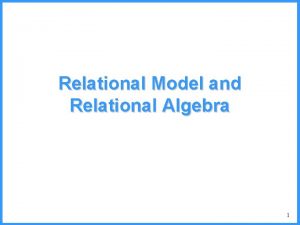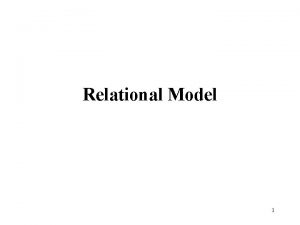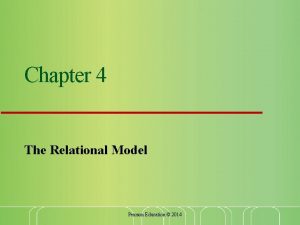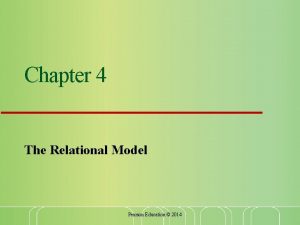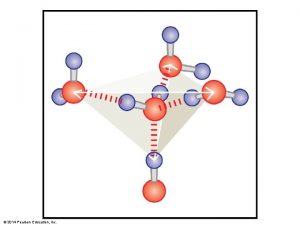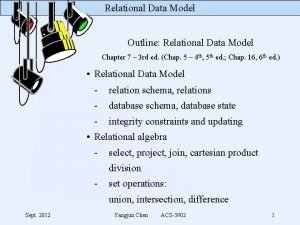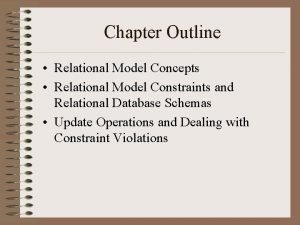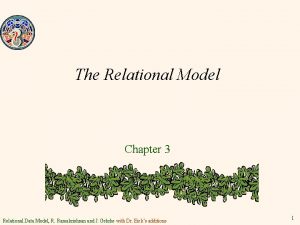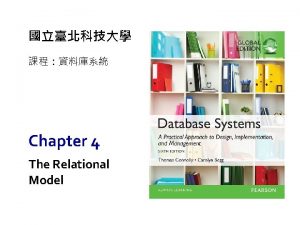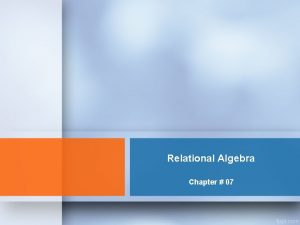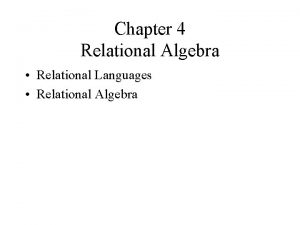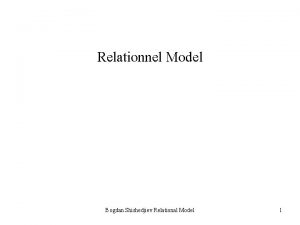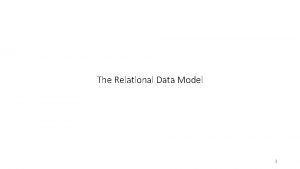CHAPTER 417 THE RELATIONAL MODEL Pearson Education 2014














































- Slides: 46

CHAPTER 4+17 THE RELATIONAL MODEL Pearson Education © 2014

OBJECTIVES • Terminology of relational model. • How tables are used to represent data. • Properties of database relations. • How to identify CK, PK, and FKs. • Purpose and advantages of views. • How to derive a set of relations from a conceptual data model. Pearson Education © 2014 2

DATABASE DESIGN Steps in building a database for an application: 1. 2. 3. 4. 5. Understanding real-world domain being captured Specify it using a database conceptual model (ER/OO) Translate specification to model of DBMS (relational) Create schema using DBMS commands (DDL) Load data(DML) Real World Domain Conceptua l model (ERD) Relational Data Model Create schema (DDL) Load Data (DML) 3

RELATIONAL MODEL TERMINOLOGY A relation is a table with columns and rows. Holds information about entities. • Only applies to logical structure of the database, not the physical structure. Attribute is a named column of a relation. Domain is the set of allowable values for one or more attributes. Every attribute in a relation is defined on a domain. Pearson Education © 2014 4

RELATIONAL MODEL TERMINOLOGY Tuple is a row of a relation. Degree is the number of attributes in a relation. Cardinality is the number of tuples in a relation. Relational Database is a collection of normalized relations with distinct relation names. Pearson Education © 2014 5

Instances of Branch and Staff Relations Pearson Education © 2014 6

Examples of Attribute Domains Pearson Education © 2014 7

ALTERNATIVE TERMINOLOGY FOR RELATIONAL MODEL Pearson Education © 2014 8

PROPERTIES OF RELATIONS Relation name is distinct from all other relation names in relational schema. Each cell of relation contains exactly one atomic (single) value. Each attribute has a distinct name. Values of an attribute are all from the same domain. Pearson Education © 2014 9

PROPERTIES OF RELATIONS Each tuple is distinct; there are no duplicate tuples. Order of attributes has no significance. Order of tuples has no significance, theoretically. Pearson Education © 2014 10

RELATIONAL KEYS Candidate Key • An attribute, or set of attributes, that uniquely identifies a tuple, and no proper subset of CK within a relation. Primary Key • Candidate key selected to identify tuples uniquely within relation. Foreign Key • Attribute, or set of attributes, within one relation that matches candidate key of some (possibly same) relation. Used to represent relationship between tuples of two relations. Pearson Education © 2014 11

INTEGRITY CONSTRAINTS Null • Represents value for an attribute that is currently unknown or not applicable for tuple. • Deals with incomplete or exceptional data. • Represents the absence of a value and is not the same as zero or spaces, which are values. Pearson Education © 2014 12

RELATIONAL INTEGRITY =INTEGRITY RULES =INTEGRITY CONSTRAINT • Data model: An integrated collection of concepts for describing and manipulating data, relationships between data, and constraints on the data in an organization. CH 2 A data model has three components: • A structural part, consisting of a set of rules according to which databases can be constructed; • A manipulative part, defining the types of operation that are allowed on the data; 13 • A set of integrity constraints, which ensures that the data is accurate.

RELATIONAL INTEGRITY There are many important integrity rules: • domain constraints • entity integrity • referential integrity • Multiplicity 14 • General constraints

RELATIONAL INTEGRITY Entity Integrity: In a base relation, no attribute of a primary key can be null. 15 Referential integrity if a foreign key exists in a relation, either the foreign key value must match a candidate key value of some tuple in its home relation or the foreign key value must be wholly null.

DATABASE RELATIONS Relation schema • Named relation defined by a set of attribute and domain name pairs. • If A 1, A 2, A 3, …, An are a set of attributes, then relation schema R is: R=(A 1, A 2, A 3, …. . , An) Pearson Education © 2014 16

DATABASE RELATIONS Relational database schema • Set of relation schemas, each with a distinct name. • If R 1, R 2, R 3, …, Rn are a set of attributes, then relation schema R is: R=(R 1, R 2, R 3, …. . , Rn) Pearson Education © 2014 17

DATABASE RELATIONS Pearson Education © 2014 18

DATABASE RELATIONS Pearson Education © 2014 19

VIEWS Base Relation • Named relation corresponding to an entity in conceptual schema, whose tuples are physically stored in database. View • Dynamic result of one or more relational operations operating on base relations to produce another relation. Pearson Education © 2014 20

VIEWS A virtual relation that does not necessarily actually exist in the database but is produced upon request, at time of request. Contents of a view are defined as a query on one or more base relations. Views are dynamic, meaning that changes made to base relations that affect view attributes are immediately reflected in the view. Pearson Education © 2014 21

PURPOSE OF VIEWS Provides powerful and flexible security mechanism by hiding parts of database from certain users. Permits users to access data in a customized way, so that same data can be seen by different users in different ways, at same time. Can simplify complex operations on base relations. Pearson Education © 2014 22

UPDATING VIEWS All updates to a base relation should be immediately reflected in all views that reference that base relation. If view is updated, underlying base relation should reflect change under the following rules: • Updates are allowed if query involves a single base relation and contains a PK of base relation. • Updates are not allowed involving multiple base relations. • Updates are not allowed involving aggregation or grouping operations. Pearson Education © 2014 23

BUILD AND VALIDATE LOGICAL DATA MODEL Derive relations for logical data model • To create relations for the logical data model to represent the entities, relationships, and attributes that have been identified. 24

Derive relations for logical data model (1) Strong entity types • • • For each strong entity in the data model, create a relation that includes all the simple attributes of that entity. For composite attributes, include only the constituent simple attributes. Derived attributes are usually omitted. FName Age Initial LName Emp. No EMPLOYEE Employee ( Emp. No, Fname, Initial, Lname ) 25

Derive relations for logical data model Multi Value Attribute • • Suppose A is a relation that contains the multivalued attribute. Create a relation R to represent the attribute. Include the PK of A as FK in R. The PK of R is the combination of the PK of A (FK) & the multivalued attribute. street Branch. No city tel. No Branch post. Co de Branch( brach. No, street, city, post. Code) Brach. Tel (tel. No, brach. No) 26

Derive relations for logical data model (2) Weak entity types • For each weak entity in the data model, create a relation that includes all the simple attributes of that entity. • The primary key of a weak entity is the partial key and its strong entity type PK. The FK will be the strong entity PK. Lname Fname Emp. No Dep. No DOB EMPLOYEE has Fname DEPENDENT Employee ( Emp. No, Lname, Fname, DOB) Dependents(Dep. No, Emp. No, Fname) 27

Derive relations for logical data model (3) One-to-many (1: *) binary relationship types • The entity on the ‘one side’ of the relationship is designated as the parent entity and the entity on the ‘many side’ is designated as the child entity. • Include the PK of the one side as a FK in the many side. • Add attributes that describes the relationship to the many side. DEPARTMENT Dept. Name 1 Dept. No M Has year STAFF Staff. NO s. Name Department (Dept. No, Dept. Name) Staff (Staff. NO, s. Name , Dept. No , year) 28

Derive relations for logical data model (4) One-to-one (1: 1) binary relationship types • Mandatory participation on both sides of 1: 1 relationship. • Mandatory participation on one side of 1: 1 relationship. • Optional participation on both sides of 1: 1 relationship. 29

Derive relations for logical data model Mandatory participation on both sides of 1: 1 relationship we should combine the entities involved into one relation and choose one of the primary keys of the original entities to be the primary key of the new relation, while the other (if one exists) is used as an alternate key (1, 1) EMPLOYEE Emp. Name Emp. ID has Year (1, 1) OFFICE Office. No Office. Loc Employee( Emp. ID, Emp. Name, Office. No, Office. Loc, Year) 30

Derive relations for logical data model Mandatory participation on one side of a 1: 1 relationship • Add the PK attributes of the optional side as a FK to the mandatory side. • Add attributes of the relationship to the mandatory side. EMPLOYEE Emp. Name (1, 1) Emp. ID has Year (0, 1) Spouse. ID SPOUSE Spoude. Name Employee(Emp. ID, Emp. Name) Spouse(Spouse. ID, Spouse. Name, Emp. ID, Year) 31

Derive relations for logical data model Optional participation on both sides of a 1: 1 relationship • Choose one side and add its PK as a FK to the other side. • Add attributes of the relationship to the other side. EMPLOYEE Emp. Name (0, 1) Emp. ID use Year (0, 1) Car. No CAR Car. Name Employee(Emp. ID, Emp. Name) Car (Car. No, Car. Name, Emp. ID, Year) 32

Derive relations for logical data model (5) Many-to-many (*: *) binary relationship types • Create a new relation with columns for the PKs of the two participating entity sets, and attributes of the relationship. • The PK of the new relation consists of the PKs of the two entities. • The PKs of the two entities also serve as foreign keys referencing the entities. M STUDENT st. Name N enroll st. No Student (st. No, st. Name) Subject (s. Code, s. Name) Enroll (st. No, s. Code, date) date SUBJECT s. Code s. Name 33

ONE-TO-ONE (1: 1) RECURSIVE RELATIONSHIPS with mandatory participation on both sides: represent the recursive relationship as a single relation with two copies of the primary key. (one copy of the primary key represents a foreign key and should be renamed to indicate the relationship it represents. ) with mandatory participation on only one side, we have the Option: to create a single relation with two copies of the primary key as described above, OR to create a new relation to represent the relationship. The new relation would only have two attributes, both copies of the primary key. As before, the copies of the primary keys act as foreign keys and have to be renamed to indicate the purpose of each in the relation. new relation as described above 34 with optional participation on both sides, again create a

Derive relations for logical data model (6) N-ary relationship • • Create a relation R to represent the relationship Include the PK of the participating entities E 1, E 2. . En as FKs in R. The combination of all FKs form the PK of R. Add the relationship attributes to R Supplier (Sname) Project (Projname) Part (Part. No) Supply (Sname, Part. No, Proj. Name, Quantity) 35

Mapping EER Mandatory/Non. Disjoint • • Suppose specialization with subclasses (S 1, S 2, . . , Sm) & a superclass C. Create a relation L to represent C with PK & attributes. Include the unshared attributes for each subclass Si, 1 i m. Add discriminator in L to distinguish the type of each tuple. 36

Mapping EER Mandatory/Non. Disjoint Emp. No Fname Salary EMPLOYEE LName DOB o Typing Speed SECRETARY TECHNICIAN Eng. Type ENGINEER TGrade EMPLOYEE( Emp. No, Fname, Lname, DOB, Salary, Typing. Speed, TGrade, Eng. Type, Secretary Flag, Technician Flag, Engineer Flag ) 37

Mapping EER Mandatory/Disjoint • Suppose specialization with subclasses (S 1, S 2, . . , Sm) & a superclass C. • Create a relation Li, 1< i < m, to represent each combination of super/subclass. • Add the PK and attributes of C to Li, 1< i < m. 38

Mapping EER Mandatory/Disjoint Emp. No Fname Salary EMPLOYEE LName DOB d Typing Speed SECRETARY TECHNICIAN ENGINEER Eng. Type TGrade SECRETARY(Emp. No, Fname, Lname, DOB, Salary, Typing. Speed) TECHNICIAN(Emp. No, Fname, Lname, DOB, Salary, Tgrade) ENGINEER(Emp. No, Fname, Lname, DOB, Salary, Eng. Type) 39

Mapping EER Optional/Disjoint • Suppose specialization with subclasses (S 1, S 2, . . , Sm) & a superclass C. • Create a relation L to represent C with PK & attributes. • Create a relation Li to represent all subclasses Si, 1< i < m. 40

Mapping EER Optional/Disjoint Emp. No Fname Salary EMPLOYEE LName DOB d Typing Speed SECRETARY TECHNICIAN ENGINEER Eng. Type TGrade EMPLOYEE(Emp. No, Fname, Lname, DOB, Salary) SECRETARY(Emp. No, Typing. Speed) TECHNICIAN(Emp. No, Tgrade) ENGINEER(Emo. No, Eng. Type) 41

Mapping EER Optional/Non. Disjoint • • Suppose specialization with subclasses (S 1, S 2, . . , Sm) & a superclass C. Create a relation L to represent C with PK & attributes. Create a relation Li to represent all subclasses Si, 1< i < m. Add discriminator in Li to distinguish the type of each tuple. 42

Mapping EER Optional/Non. Disjoint Emp. No Fname Salary EMPLOYEE LName DOB o Typing Speed SECRETARY TECHNICIAN ENGINEER Eng. Type TGrade EMPLOYEE(Emp. No, Fname, Lname, DOB, Salary) SUB-EMP(Emp. No, Typing. Speed, TGrade, Eng. Type, Secretary Flag, Technician Flag, Engineer Flag) 43

Guidelines for representation of superclass / subclass relationship 44

Summary of how to map entities and relationships to relations 45

SUMMARY • • • Relational database. Relation, attribute, tuple, degree, cardinality. Primary key, Foreign key. Relational schema, Relational database schema. Views. 46
 2014 pearson education inc
2014 pearson education inc 2014 pearson education inc
2014 pearson education inc 2014 pearson education inc
2014 pearson education inc 2014 pearson education inc
2014 pearson education inc 2014 pearson education inc
2014 pearson education inc 2014 pearson education inc
2014 pearson education inc Water cycle pearson education
Water cycle pearson education 2014 pearson education inc
2014 pearson education inc 2014 pearson education inc
2014 pearson education inc 2014 pearson education inc
2014 pearson education inc 2014 pearson education inc
2014 pearson education inc 2014 pearson education inc
2014 pearson education inc Pearson education
Pearson education 2014 pearson education inc
2014 pearson education inc 2014 pearson education inc
2014 pearson education inc 2014 pearson education inc
2014 pearson education inc 2014 pearson education inc
2014 pearson education inc 2014 pearson education inc
2014 pearson education inc Copyright 2014 pearson education inc
Copyright 2014 pearson education inc 2014 pearson education inc
2014 pearson education inc 2014 pearson education inc
2014 pearson education inc 2014 pearson education inc
2014 pearson education inc 2014 pearson education inc
2014 pearson education inc 2014 pearson education inc
2014 pearson education inc 2014 pearson education inc
2014 pearson education inc 2014 pearson education inc
2014 pearson education inc 2014 pearson education inc
2014 pearson education inc 2014 pearson education inc
2014 pearson education inc 2014 pearson education inc
2014 pearson education inc 2014 pearson education inc
2014 pearson education inc Pearson education, inc. publishing as prentice hall
Pearson education, inc. publishing as prentice hall Pearson education inc publishing as pearson prentice hall
Pearson education inc publishing as pearson prentice hall Pearson education inc publishing as pearson prentice hall
Pearson education inc publishing as pearson prentice hall Pearson education inc. 2012
Pearson education inc. 2012 Pearson education inc publishing as pearson prentice hall
Pearson education inc publishing as pearson prentice hall The limited tuple relational calculus equals:
The limited tuple relational calculus equals: Relational calculus
Relational calculus Relational algebra and relational calculus
Relational algebra and relational calculus Object relational and extended relational databases
Object relational and extended relational databases Relational algebra and calculus
Relational algebra and calculus Southwest flight 417
Southwest flight 417 417 studies
417 studies Cmsc 417
Cmsc 417 Cmsc 417
Cmsc 417 417 extension
417 extension Ece 417
Ece 417 Cmsc 417
Cmsc 417












